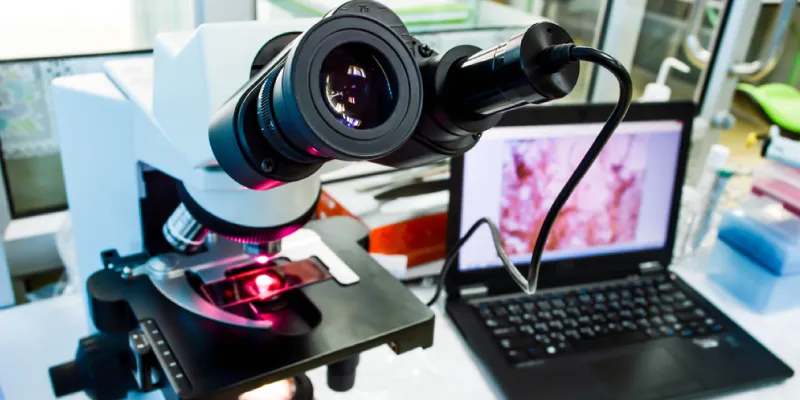The path to digital pathology: is one of medicine’s core fields ready for digitization?
Digitizing the present-day pathology lab may pave the way for a long-awaited future-ready overhaul.
For the past 150 years, pathology has been the essence of medicine. The pathology lab has been a front for understanding diseases and disease diagnosis for decades. Considering this, it’s remarkable that the field has barely seen significant changes. While the medical industry has been blessed with incredible technology on other fronts, the core of the diagnosis process continues to lean heavily on pathologists in labs.
As global healthcare standards keep escalating, the need for an overhaul of pathology is even more anticipated than ever before. Pathology needs to keep pace with the times – this means the ability to work faster, with greater efficiency, and larger scalability. Therein lies the rise of digital pathology.

Paving the way for digital pathology
Despite witnessing the rapid development of innovative medical technology such as blood-drawing robots, augmented reality, synthetic tissues, and machine-run organs, pathology continues to rely on the same old method – looking at tissues with a microscope within laboratory walls.
As we move closer to 2020, the number of active pathologists in the field is reducing. According to recent studies, the number of active pathologists may drop by a massive 30 percent by then as compared to the active number in 2010. The ratio of pathologists to patients is always extremely skewed towards being unfavourable for the former. Paired with an increasing pressure to move faster and more efficiently, pathology labs need to find ways to not only better assist pathologists but also in a way that’s future-ready, efficient, and scalable. Digital pathology holds the answer to this need, and much more.
For starters, it’s a great answer to the gradually reducing count of practising pathologists. The element of time-saving comes into play, allowing pathologists to get more samples analysed in half the time. Pathologists could start sharing their slides on a cloud server which could be accessible to all, reducing time lost in accessibility to a great degree. This paves the way for computerized quantitative analytics, speedy image search, and faster slide retrieval in an instant.
Pair all of the above with a total digitization of the workflow. Digitization of the workflow will further enable better and faster diagnosis. The process of whole-slide imaging can be improved significantly. Access to digitized whole-slide imaging allows capture of entire tissues on a single slide, as opposed to the narrow view a microscope lends. This enables greater accuracy and reduces subjectivity. All of this makes sending slides and data for consultation far easier than it is at present, allowing for greater facilitation of discussion and second opinions. This also opens doors for the possibility of virtual pathology services in the more remote areas.
Deep learning could bring in the much-needed automation aspect that pathology needs. With data sets that are relatively large in size, deep learning algorithms will be nothing short of the jackpot for pathologists. Deep learning could be utilized for classification of digitized pathology slides. This process enables pathologists to spend more time on cases that demand greater attention, setting aside the less important cases for later. This saves time again, further counteracting the effect of the reducing number of pathologists worldwide.
Add the capacity of artificial intelligence in the fray and we could be looking at a well-rounded process from all ends. Artificial intelligence, when capable, can spot connections, links, and anomalies that could be missed by pathologists themselves. Comparative analytics with historical data and data from other sources will bring about higher accuracy in diagnosis, in far shorter timeframes. The rapid analysis will speed the precision of diagnosis greatly, redefining not just how we see several diseases, but also how patients respond to them. A recent study showcased that combining deep learning prediction capabilities with human pathologists’ diagnoses for identifying metastatic breast cancer resulted in a staggering 85 percent reduction in human error rate.
Finally, the icing on the proverbial cake here would be the addition of biotechnology to enable precision medicine. Digital technologies will pave the way for point-of-care testing alternatives for pathology in the near future. Portable diagnostic devices are already making a name for themselves, allowing for examination of tissues, fluids, and other relevant samples near the patient’s locations itself. The widening of the field of point-of-care testing will be catalyzed by digitization. Molecular analysis will allow for more precise diagnosis in the years to come. The pathologist needs to simply pick out which molecules need to be evaluated.
Like its sister concern radiology, pathology too requires a diagnostic process. Digital imaging methods have been improving in radiology for a while now, and it’s only a matter of time before the addition of greater imaging methods will transform pathology as well. Unlike radiology though, the addition of technology will not take jobs away from pathology; human beings will continue to be at the forefront of looking through the microscope – with the added collaborative benefit of cutting-edge technology.
Is digitisation the way to go?
The medical industry is undergoing a massive overhaul in all fields, and it’s about time pathology received a little love too. Pathologists and patients both stand to benefit from this. The advent of newer technology means the scope for existing businesses to grow only gets better. Simply by virtue of being able to do more in the lab than before, pathologists could increase the number of patrons served by a significant margin. Pair that with the ability to obtain results faster, and we have the right formula for an up-scaling of the industry. The fruit is ripe to pluck for those in the field.
However, pathologists do need to be cognizant of several key aspects of the process. For starters, having the right equipment and appropriate complementary software is not only crucial for those analyzing samples, but also for those diagnosing them. Digital pathology will also create fresh challenges from the legal, security, privacy, and confidentiality standpoints. Standardization across the board is the most crucial aspect to keep in mind for newer organizations making a push to adopt digital pathology.
The bottom-line verdict? With powerful tools at their disposal, pathologists could unlock more powerful digital imaging methods which in turn opens the doors to plentiful opportunities in the future. There’s no question – digital pathology is the path to trudge into the present, and indeed, the future.
Ashissh Raichura is a veteran techie and serial entrepreneur with over 25 years of diverse experience to his name, and currently the Founder of Scanbo.
(Disclaimer: The views and opinions expressed in this article are those of the author and do not necessarily reflect the views of YourStory.)







